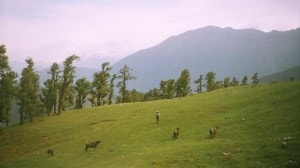A dino egg and other fossils
Ghughua,a village in Madhya Pradesh,has animal and plant fossils that go back 65 million years....
Think dinosaurs and you think Steven Spielbergs Jurassic Park. But think dinosaur egg and you may well give a thought to the National Fossil Park in Ghughua,a village in Madhya Pradesh that houses this and many other animal and plant fossils as old as 65 million years.
Visited mainly by paleobotany students,scientists and archeologists,the fossil park is around 76 km away from Jabalpur in Madhya Pradesh and spread over an area of 27.34 ha in Ghughua and Umaria villages in Dindori district of Madhya Pradesh.
According to scientists who have studied Ghughua in detail,in ancient times,this village had a humid and equatorial climate,with uniform temperatures throughout the year and an annual rainfall above 2,000 mm or more as compared to about 1,400 mm now. Fossils like mollusk,which are found here,indicate the presence in those times of a large waterbody in this region. Some scientists have speculated that an ancient branch of the sea,called the Tethys Sea,extended up to Ghughua.
It was Dr Dharmendra Prasad,statistical officer of Mandla district and honorary secretary of the district archeology union,who discovered the fossils in Ghughua in the 70s. Dr S.R. Ingle from Science College,Jabalpur,and Dr M.B. Bande from Birbal Sahani Institute of Paleobotany,Lucknow,then conducted systematic study of these fossils.
Jaswant Singh Guleria,a senior scientist associated with the Birbal Sahni Institute on Paleobotany,says,In the last stages of the Lower Cretaceous Era,the plants with uncovered seeds like pteridophytes and gymnosperms,which dominated the earth for a long time,began to diminish and were soon replaced by flowering plants.
The park has a museum,which has a collection of various fossils. What holds the attention of the kids is the dinosaur egg, says Khyati Yadav,who works as a guide at Ghughua.
Besides the museum,a walk in the park can transport you to another time in the past. A concrete road runs through the park and fossils of different shapes and sizes are kept on both sides.
Considering the scientific importance of the fossils found in this region,the state government notified this area as the Ghughua Fossil National Park in 1983. So far,31 fossil genera belonging to 18 families have been identified.
Scientists say that though these are fossils of plants that became extinct million of years ago,they bear close similarity to plants found these dayslike the jackfruit tree,rudraksh,jamun and amla.
- 01
- 02
- 03
- 04
- 05































